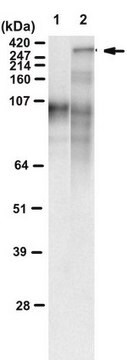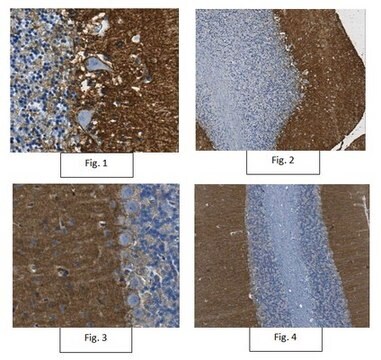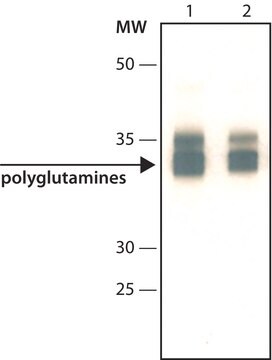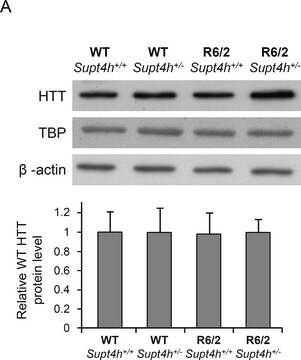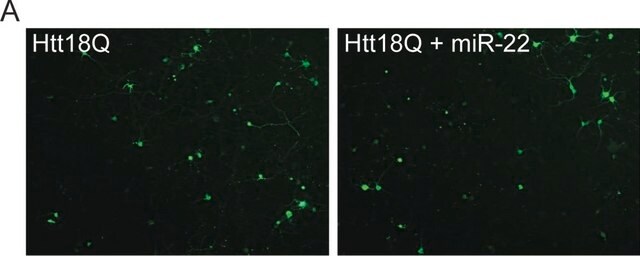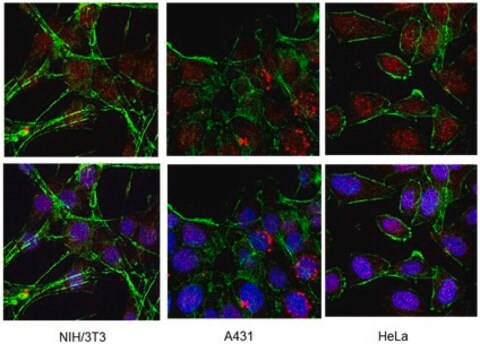MABN821
Anti-polyQ Disease Proteins Antibody, clone 3B5H10
clone 3B5H10, from mouse
Sinonimo/i:
Huntingtin mutants with expanded polyQ repeats, HD protein, Huntington disease protein, mHtt, PolyQ disease proteins
About This Item
Prodotti consigliati
Origine biologica
mouse
Livello qualitativo
Forma dell’anticorpo
purified antibody
Tipo di anticorpo
primary antibodies
Clone
3B5H10, monoclonal
Reattività contro le specie
human
tecniche
electron microscopy: suitable
immunocytochemistry: suitable
immunohistochemistry: suitable
inhibition assay: suitable
western blot: suitable
Isotipo
IgG1
N° accesso UniProt
Condizioni di spedizione
ambient
modifica post-traduzionali bersaglio
unmodified
Informazioni sul gene
human ... HTT(3064)
Descrizione generale
Specificità
Immunogeno
Applicazioni
Immunocytochemistry Analysis: A representative lot immunostained neurons transiently expressing Huntington (Htt) or Ataxin-3 with disease-associated polyQ expansions (Q46 to Q138), but not neurons expressing Htt with Q17 or Ataxin-3 with Q27. Clone 3B5H10 stained diffuse mutant Htt (mHtt), but not aggregated Htt in large inclusion bodies (IBs) (Miller, J., et al. (2011). Nat. Chem. Biol. 7(12):925-934).
Immunohistochemistry Analysis: A representative lot immunostained brain tissue sections from transgenic mice expressing disease-associated human mutant Huntinton (mHtt) proteins, including murine strains BACHD (full-length mHtt with Q97), R6/2 (Exon 1 fragment with ~Q150), and YAC-SCA3 (full-length mHtt with Q84). Clone 3B5H10 stained diffuse mHtt and failed to stain tissue with extensively aggregated Htt unless strong antigen retrieval by 90% formic acid treatment was performed (Miller, J., et al. (2011). Nat. Chem. Biol. 7(12):925-934).
Inhibition Analysis: A representative lot prevented the aggregation of mutant Htt (mHtt) exon 1 fragment with Q39 or Q53 and disrupted pre-aggregated mHtt oligomers and fibrils into monomer in vitro by atomic force microscopy (AFM) and dynamic light scattering (DLS) measurement (Miller, J., et al. (2011). Nat. Chem. Biol. 7(12):925-934).
Western Blotting Analysis: A representative lot detected Huntington (Htt), androgen receptor (AR), and atrophin constructs with disease-associated polyQ expansions (Q65 to Q103), but not constructs with Q19 or Q25, exogenously expressed in HEK293 and PC12 cells. Clone 3B5H10 detected monomeric and possibly small oligomeric mHtt N-terminal fragments, but not large oligomers or high molecular weight aggregates (Miller, J., et al. (2011). Nat. Chem. Biol. 7(12):925-934).
Qualità
Western Blotting Analysis: 0.5 µg/mL of this antibody detected exon 1-coded N-terminal Huntington fragment with 134-glutamine/Gln (134Q) expansion, but not the corresponding normal (wild-type) fragment with 17Qs.
Descrizione del bersaglio
Stato fisico
Altre note
Non trovi il prodotto giusto?
Prova il nostro Motore di ricerca dei prodotti.
Raccomandato
Codice della classe di stoccaggio
12 - Non Combustible Liquids
Classe di pericolosità dell'acqua (WGK)
WGK 1
Punto d’infiammabilità (°F)
Not applicable
Punto d’infiammabilità (°C)
Not applicable
Certificati d'analisi (COA)
Cerca il Certificati d'analisi (COA) digitando il numero di lotto/batch corrispondente. I numeri di lotto o di batch sono stampati sull'etichetta dei prodotti dopo la parola ‘Lotto’ o ‘Batch’.
Possiedi già questo prodotto?
I documenti relativi ai prodotti acquistati recentemente sono disponibili nell’Archivio dei documenti.
Il team dei nostri ricercatori vanta grande esperienza in tutte le aree della ricerca quali Life Science, scienza dei materiali, sintesi chimica, cromatografia, discipline analitiche, ecc..
Contatta l'Assistenza Tecnica.